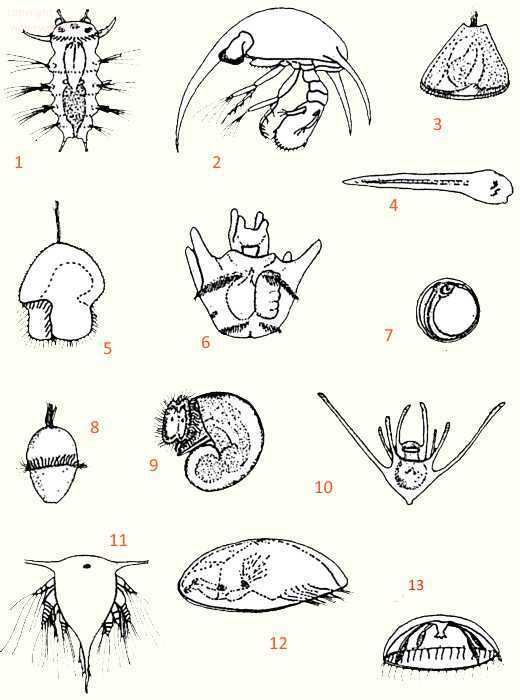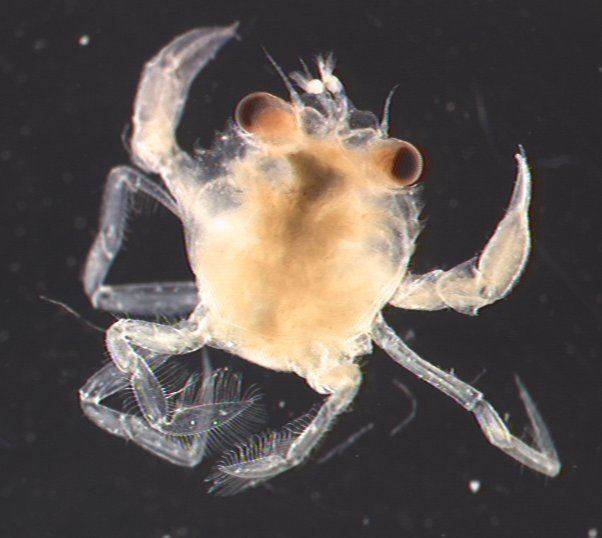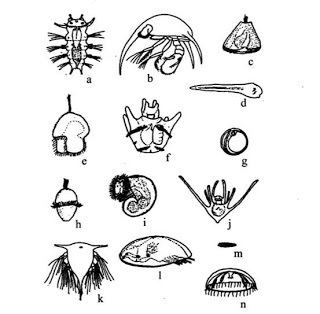Length Red king crab: 1.8 m | ||
Lifespan Enteroctopus dofleini: 3 – 5 years Mass Atlantic bluefin tuna: 380 kg, Enteroctopus dofleini: 15 kg, Enteroctopus megalocyathus: 4 kg Representative species Diatom, Hemichordate, Atlantic bluefin tuna, Coconut crab, Human pinworm | ||
Meroplankton is a term used to describe a wide variety of planktonic organisms, which spend a portion of their lives in the benthic region of the ocean. These organisms do not remain as Plankton permanently, rather, they are planktonic components in transition, which eventually become larger organisms. After a period of time in the plankton, meroplankton either graduate to the nekton or adopt a benthic (often sessile) lifestyle on the seafloor. Meroplankton consists of larval stages of organisms such as sea urchins, starfish, crustaceans and dinoflagellates and diatoms. Meroplankton forms an algal medium that is found between the loosely mixed sediments and water. This layer can be re-suspended in the water column by turbulent mixing. Success of meroplankton populations depends on many factors, such as adult fecundity, fertilization success, growth and larval stage duration, behaviour, dispersal, and settlement. Mortality depends on many factors, such as predation, competition, disease, parasites, and physiological stresses. Survival and mortality of meroplankton has a direct effect on adult population numbers of many species. Many of the common, well-known animals found on the Great Barrier Reef spend time as free-swimming meroplankton, bearing little or no resemblance to the adult they will become. The differences between the appearance of larval and adult stages led to much confusion in the past when larval forms were often believed to be completely different species from the adults. Larvae spend varying amounts of time in the plankton, from minutes to over a year. However, just how long these tiny animals can be considered truly planktonic is under some debate.
Contents
- Spatial distribution
- Dispersal
- Food availability
- Diversity and abundance
- Effects of pollution
- Meroplankton and climate change
- References

Spatial distribution

Meroplankton species composition depends on spatial distribution and reproductive habits of adults in a given area. Biotic and abiotic factors such as tidal and lunar cycles and availability of food determine adult spawning schedules, in turn, determining subsequent meroplankton populations. Behavioural factors, such as predator avoidance are also important. Freshwater inputs play a key role in meroplankton species composition in estuarine environments. Effects of tides contribute greatly to meroplankton species distribution. One study conducted in a Patagonian Fjord found that species composition of the meroplankton community depended on the seasonally varying input levels from the Baker river as well as vertical and horizontal stratification of the water column. Events such as wind driven upwelling and downwelling also affect meroplankton species distribution. Most species are swept in the direction of the flow of water, either off shore during an upwelling or near shore during a downwelling. Some species, such as bivalve larvae, have the ability to maintain their nearshore position during these events.
Dispersal

Survival rate of Meroplankton is critical to successful development of adult organisms. Low survival rates of meroplankton will result in reduction in adult population numbers. One factor which often determines meroplankton survival is larval dispersal. Most species within the meroplankton community rely on ocean currents for dispersal. Currents play a key role in delivering larval organisms to specific settlement locations, where they are able to transition and mature into adult forms. Organisms which do not make it to the right settlement site are unlikely to complete their lifecycle. Scientists in recent years have also discovered that many of these tiny animals in the plankton (in particular larval fish and crustaceans) quickly become very good swimmers capable of incredible feats of speed and endurance.
Food availability
A major factor affecting meroplankton survival is food availability. While living in the plankton, meroplankton either feed on other members of the plankton, or they live off the yolk they have retained from the egg they hatched from. Many members of the meroplankton community rely on the surrounding planktonic community for nutrition. In order to ensure that larvae have sufficient amounts of nutrition, many species coordinate larval release with times of algal blooms. This synchronicity between release of larvae and algal blooms often leads to Meroplankton making up the largest percentage of the planktonic community during such reproductive periods. It has been demonstrated that certain species are able to commence spawning as they come into contact with phytoplankton cells. These species store embryos in the mantle cavity until they detect algal blooms. This adaptation allows for better larval survival.
Diversity and abundance

Meroplankton diversity and abundance are affected by many factors. Seasonal and spatial variations are among some of the main causes of such variability. A study which was conducted in Dunkellin Estuary, determined that spawning times of many species are timed to maximize food availability at a particular time of year, while minimizing presence of other species which exploit the same food source Diversity and abundance are depth dependent qualities. Generally, shallow coastal waters contain far greater numbers of meroplankton than deep, open ocean waters. Most abundant regions occur at depths between 0 and 200 meters of the water column, where light penetration is highest. Availability of sunlight allows for proliferation of phytoplankton, which serves as one of the major food sources for meroplankton. Deep oceanic waters show significantly lower abundance than shelf regions, due to poor light penetration.
Effects of pollution

Water and benthos pollution from industrial sources has been demonstrated to have varying effects on biological diversity and survival potential of meroplankton. One study conducted in the Vostok Bay region in Russia, demonstrated that even in the presence of industrial pollutants, most species of meroplankton were able to proliferate almost unaffected. The authors of this study attribute these findings to the fact that meroplankton are transported by ocean currents generally from cleaner open waters inshore. Furthermore, the same study also concluded that even in heavily polluted areas, meroplankton populations were able to reestablish if pollution was brought under control and sufficient time was allowed to pass. However, the rate of recolonization was demonstrated to be notably slow, on average talking about 10 years before the abundance and diversity of meroplankton returned to its original levels. This is in part due to the slow nature of detoxification of benthic sediments, which retain much of the heavy metal pollution
Meroplankton and climate change
A study conducted in the North Sea between 1958-2005, collected samples of meroplankton using a CPR survey. These samples consisted of larval echinoderms, decapods, bivalves, cirripedes, and ectoprocts. Meroplankton abundance as well as PCI levels (amount of chlorophyll in each sample in relation to sea surface temperature) were examined. Researchers concluded that echinoderm larvae increased in abundance throughout the study, with the largest increase occurring in the Northern and Central regions. Decapod larvae were found to increase in abundance as well, and were found to appear earlier in the year. Bivalve larvae showed an overall decline in abundance. It was also concluded that PCI levels increased throughout the study, particularly during the summer months. It was determined that climate, particularly sea surface temperature, drives meroplankton abundance. Warmer sea surface temperature shortens developmental time of the larvae, increasing their survival rate.
